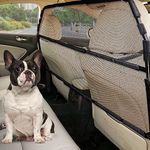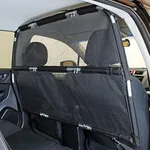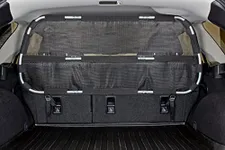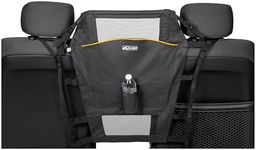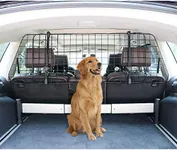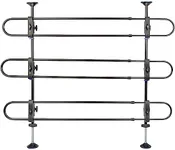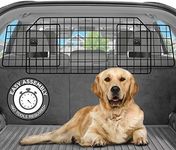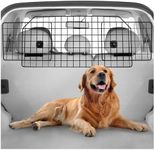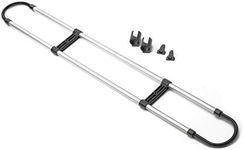Buying Guide for the Best Dog Car Barriers
Choosing the right dog car barrier is important for both your pet’s safety and your own peace of mind while driving. A good barrier keeps your dog secure in a designated area, preventing distractions and potential accidents. When shopping for a dog car barrier, it’s essential to consider your vehicle type, your dog’s size and temperament, and how often you’ll be using the barrier. Understanding the key features will help you find a barrier that fits your needs and ensures a comfortable and safe journey for everyone.Barrier TypeThe type of barrier refers to its design and how it fits in your car. Common types include mesh, metal, and plastic barriers, as well as adjustable gates. Mesh barriers are lightweight and easy to install, making them suitable for calm dogs and short trips. Metal and plastic barriers are sturdier and better for larger or more energetic dogs. Adjustable gates can fit a range of vehicle sizes and are ideal if you switch cars often. To choose the right type, consider your dog’s behavior and the level of containment you need—calmer dogs may do well with mesh, while strong or active dogs may require a more robust barrier.
Size and AdjustabilitySize and adjustability refer to how well the barrier fits your specific vehicle and how easily it can be modified to suit different spaces. Some barriers are designed for SUVs, while others fit sedans or hatchbacks. Adjustable barriers can expand or contract to fit various widths and heights. It’s important to measure your car’s interior and compare it to the barrier’s dimensions. If you have multiple vehicles or plan to change cars, an adjustable barrier offers more flexibility. Always ensure the barrier covers the entire gap to prevent your dog from squeezing through.
Installation MethodThe installation method describes how the barrier is secured in your car. Some barriers use pressure mounts, which are easy to install and remove without tools, while others require hardware or straps for a more permanent setup. Pressure-mounted barriers are convenient for temporary use or frequent removal, but may not be as secure for strong dogs. Hardware-mounted barriers are more stable and suitable for long-term use or for dogs that might push against the barrier. Consider how often you’ll need to remove the barrier and how much effort you’re willing to put into installation.
Material and DurabilityMaterial and durability refer to what the barrier is made of and how well it stands up to wear and tear. Barriers can be made from metal, plastic, or fabric mesh. Metal barriers are the most durable and can withstand chewing or scratching, making them ideal for large or determined dogs. Plastic barriers are lighter and easier to handle but may not be as tough. Mesh barriers are soft and lightweight, best for gentle dogs. Think about your dog’s habits—if your dog is likely to chew or push against the barrier, opt for a stronger material.
Visibility and AirflowVisibility and airflow are about how much your dog can see through the barrier and how well air circulates. Barriers with open designs, like mesh or bars, allow your dog to see you and get plenty of air, which can reduce anxiety and keep them comfortable. Solid barriers may block the view and airflow, which could make some dogs uneasy. If your dog is calmer when they can see you, or if you travel in hot weather, choose a barrier that doesn’t block sightlines or ventilation.

